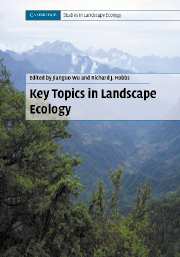Book contents
- Frontmatter
- Contents
- List of contributors
- Preface
- PART I Introduction
- PART II Key topics and perspectives
- 2 Adequate data of known accuracy are critical to advancing the field of landscape ecology
- 3 Landscape pattern analysis: key issues and challenges
- 4 Spatial heterogeneity and ecosystem processes
- 5 Landscape heterogeneity and metapopulation dynamics
- 6 Determining pattern–process relationships in heterogeneous landscapes
- 7 Scale and scaling: a cross-disciplinary perspective
- 8 Optimization of landscape pattern
- 9 Advances in detecting landscape changes at multiple scales: examples from northern Australia
- 10 The preoccupation of landscape research with land use and land cover
- 11 Applying landscape-ecological principles to regional conservation: the WildCountry Project in Australia
- 12 Using landscape ecology to make sense of Australia's last frontier
- 13 Transferring ecological knowledge to landscape planning: a design method for robust corridors
- 14 Integrative landscape research: facts and challenges
- PART III Synthesis
- Index
- References
14 - Integrative landscape research: facts and challenges
Published online by Cambridge University Press: 12 January 2010
- Frontmatter
- Contents
- List of contributors
- Preface
- PART I Introduction
- PART II Key topics and perspectives
- 2 Adequate data of known accuracy are critical to advancing the field of landscape ecology
- 3 Landscape pattern analysis: key issues and challenges
- 4 Spatial heterogeneity and ecosystem processes
- 5 Landscape heterogeneity and metapopulation dynamics
- 6 Determining pattern–process relationships in heterogeneous landscapes
- 7 Scale and scaling: a cross-disciplinary perspective
- 8 Optimization of landscape pattern
- 9 Advances in detecting landscape changes at multiple scales: examples from northern Australia
- 10 The preoccupation of landscape research with land use and land cover
- 11 Applying landscape-ecological principles to regional conservation: the WildCountry Project in Australia
- 12 Using landscape ecology to make sense of Australia's last frontier
- 13 Transferring ecological knowledge to landscape planning: a design method for robust corridors
- 14 Integrative landscape research: facts and challenges
- PART III Synthesis
- Index
- References
Summary
Introduction
There are many tensions in landscape management at spatial scales from individual fields to regions and upwards to global environmental change (Dalgaard et al. 2003). Farmers are under increasing pressure to produce nonfood products including recreational opportunities, attractive landscapes, and habitats for wildlife. The many different forms of agri-environmental payment schemes are witness to these pressures. In urban landscapes we see a new emphasis on urban green space, urban green structures, and greenways fulfilling multiple goals (Fábos 2004, Gobster and Westphal 2004).
One of the trends in the funding of landscape research over the last 20 years has been the rapid growth of large-scale integrative projects (Höll and Nilsson 1999, Tress et al. 2005a). This trend must be seen against the background of environmental concerns that have placed greater demands on the way landscapes are managed and the widening range of objectives they should fulfil. This has fuelled the demand for new research tools to address these problems. Since the problems are complex and span several disciplines, it was natural to consider integrative forms of research as the way forward (Balsiger 2004). In this chapter, we explore several of the major concepts associated with integrative research modes, what funding bodies and researchers expect from such research, and what is being delivered. We discuss the organisational barriers to integration, merit system, and ways to improve the theory base. Finally, we present education and training needs for integrative research and recommend measures to enhance integrative landscape research.
- Type
- Chapter
- Information
- Key Topics in Landscape Ecology , pp. 246 - 268Publisher: Cambridge University PressPrint publication year: 2007
References
- 12
- Cited by

